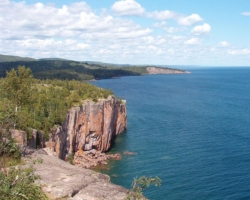Minnesota
Minnesota is a state in the Midwestern United States. Minnesota shares a water border with Michigan and a land and water border with Wisconsin to the east. Iowa is to the south, North Dakota and South Dakota are to the west, and the Canadian border is to the north.
- ABBREVIATION: MN
- NICKNAME: The North Star State
- POPULATION: 5,420,380 (2013 est.)
- CAPITAL: Saint Paul
- STATE BIRD: Common Loon
- STATE FLOWER: Lady Slipper
- AREA: 86,939 sq. mi.
- TIME ZONE: Central
- ENTERED UNION: May 11, 1858
- ALTITUDE: High, 2,302 ft. Eagle Mountain
- CLIMATE: Long cold winters, short summers; moderate rainfall.


Here, Minnesotans like to say, is the land of the good life. With more than 11,000 clear blue lakes scattered through the state’s level plains, rugged hills and valleys, 9 out of every 10 people are within 10 miles of a body of water alive with wall-eyed pike, trout, bass and darting slopes. One of the most popular of the vacation states, Minnesota is a sportsman’s paradise. According to legend, its lakes were created when Paul Bunyan, the giant of the woods, let his axe drag on the ground behind him. A more prosaic age attributes their formation to glacial action, but their vigorous outdoor tradition remains.
The “bread-and-butter skyline” of the grain mills and creameries in Minneapolis attests the fact that the state is a major producer of creamery butter and a major source of milk, oats, corn, barley, spring wheat and hay. Even though less than 1% of the population is employed in the agricultural sector, it remains a major part of the state’s economy, ranking 6th in the nation in the value of products sold. In addition, Minnesota has the most food cooperatives per capita in America.

Minnesota has only one major metal, but it is a mighty one-iron. In the Northeast , in the gentle hills of the glacier-leveled Mesabi Range lies one of the biggest man-made holes in the world, the open pits of the Hull-Rust-Mahoning mine; more than three miles long, two miles wide and 535 feet deep, this man-made “Grand Canyon of the North” was the first strip mine on the Mesabi Iron Range. Minnesota was famous for its soft-ore mines, which produced a significant portion of the world’s iron ore for over a century.
FUN FACTS:
- The first cellophane tape was produced by Minnesota Mining and Manufacturing (3M) Company in 1932.
- In-line skates were invented by two Minnesota students. Looking for a way to practice hockey in the summer, they replaced the blades on their skates with wheels.
- The opening of the St. Lawrence Seaway in 1959 connected the Port of Duluth and the Atlantic Ocean.
- The world’s first open-heart operation was performed at the University of Minnesota in 1952, and Rochester is home to the world-famous Mayo Clinic.
- Minnesota’s total shoreline adds up to 90,000 miles, more than California, Florida and Hawaii combined.
- During a baseball broadcast, Minnesotan baseball commentator Halsey Hal is credited to be the first person to say “Holy Cow” during a baseball broadcast.
